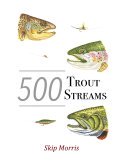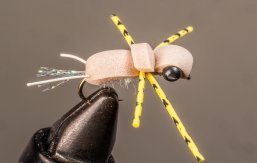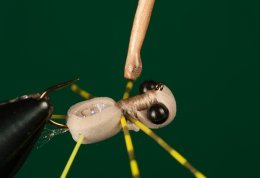Wet Fly Hackles, Part 1:
Choosing the Right Materials
In this article, Wet Fly Hackles, Part 1, fly fishing and tying authority Skip Morris discusses the debate about which materials are the best
for wet fly hackles.
In part 2, Skip shows you how to tie them, demonstrating three distinct approaches: the standard, half-stripped, and reverse-wound methods.
The Debate About Wet Fly Hackles
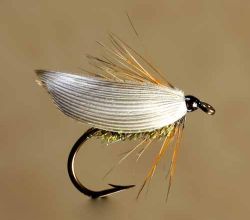 A classic wet fly, the Leadwing Coachman
A classic wet fly, the Leadwing Coachman
tied by Skip Morris
The debate over just what sort of hackle is proper in a wet fly is nothing new.
In A Book of Trout Flies, published in 1938,
which seems like quite a while ago when viewed from our twenty-first-century perspective, author Preston Jennings
gives us his opinion on the matter:
"Flies tied for use in fishing downstream usually have hard hackles, so that they will not mat and cover the body of the fly as it is drawn across and against the current.
Flies tied for fishing up-stream have soft hackles, so that the hackles will readily respond to the influence of the current as the fly is carried down-stream without any action being imparted to it by the angler."
Jennings clearly felt that the stiffness of wet fly hackles was an important matter.
And he was right, so far as I am concerned.
A Varied Opinion and a Case to Consider:
Hard Hackles vs. Soft Hackles
But I'm not quite on board with him regarding specifics.
I fish wet flies all the time for sea-run cutthroat trout and Pacific salmon with the old toss-it-out-and-jerk-it-back approach—just the situation for
Jennings's "hard hackles"—yet I prefer fairly soft-fiber hackles, because in between the jerks are brief pauses when supple fibers can billow
out in a lively manner.
When the wet fly is fished quietly—dead-drift or with the gentle across-current-soft-hackle-fly approach—
soft, pliant hackle are the obvious and logical choice.
So regardless of whether I plan to really work a wet fly across a current or
lightly tease it across instead, I still want that fly to contain hackles with at least fairly supple fibers.
This is why, in my opinion, dry-fly and most rooster chicken hackles are out, and why softer hen chicken hackles make sense.
Hen hackles, from both the neck and saddle,
are nearly always softer than hackles from any part of a rooster.
Calling on an Expert:
Dave Hughes, Fly Fishing Author
and Wet Fly Devotee
But I'm no expert on the subject. So I'd like to quote a contemporary devotee of the wet fly, my friend Dave Hughes.
Dave's considerable research for Wet Flies, a skillfully written and ample exploration of the wet fly and related fly-types, coupled with his
longtime fascination with the traditional wet fly and such relatives as the soft-hackle fly and the flymph make his opinions on wet-fly hackles well worth considering.
For Traditional Wet Flies:
The Finest Grade of Hen Neck
So I gave him a call, and this is what he told me. While Dave prefers hackles that are exceptionally soft, such as partridge and hen saddle,
for soft-hackles, he prefers the finest grade of hen neck for traditional wet flies. He looks especially for consistency of fiber-length
and for sheen, the kind of sheen, he says, you find on a good dry-fly hackle.
He also likes hen-saddle hackle as an alternate
for especially big wet flies.
Well, Dave's the expert, but nevertheless I'll add that for really big wet flies, such as the kind designed for
sea-run cutthroat trout, I'm a big fan of Chickabou hackle, from Whiting. I'm speaking here of fly patterns that are not traditional wet flies, but many
are so close to them in form that I thought it worth mentioning.
Hackle-Fiber Length
Regarding hackle-fiber length, Dave says the norm is one-and-a-half to two times the hook's gape, just as with the traditional dry fly.
But he prefers that his wet-fly hackles are a full two times the gape, the high end of the standard range.
Fiber-Flexibility from a Trout's Perspective
Remember: fiber-flexibility in wet-fly hackles is a fine point—no trout is going to refuse your Dark Cahill simply because its hackle fibers
don't flex in just the right way.
Still, every tier wants his or her flies to be their best, and the preceding should help you make sound choices
in hackles for your wet flies. So, having selected your hackles, let's explore some ways to construct wet-fly hackle collars with them.
Methods for Wrapping Wet-Fly Hackles
There are several good methods for creating a wet-fly hackle collar, and though each method has its drawbacks, each also offers specific advantages.
The Standard Approach
The standard approach of wrapping the hackle forward, then binding its tip, is the easiest. And it's probably just fine from the trout's perspective.
The Half-Stripped Hackle
The half-stripped hackle offers a very sparse collar—just right for persnickety trout and a dead-drift or barely manipulated fly.
And only one simple step is added to the standard approach.
The Reverse-Wound Hackle
The reverse-wound hackle isn't much more difficult to make than the standard, just a couple of quick extra steps.
The big advantages to this method are:
- the stem of the hackle is reinforced by turns of thread, and consequently made tougher, and
- the fibers slant naturally back, and can be slanted further with a couple of quick pinches.
The folded hackle is more involved and more time-consuming to make than the aforementioned types; describing it well really requires the space of a whole article, not just a little space in this one. But the folded hackle is worth investigating; perhaps we'll do so together in a future issue.
Skip demonstrates each of the three methods he describes above for wrapping wet fly hackles in Wet Fly Hackles, Part 2, Tying Steps.
Click here to hear Skip's interviews on popular podcasts...
*Announcements*
Skip has an essay in Big Sky Journal's annual Fly Fishing issue, called "Montana Hoppers: the Princess and the Brute" released February 1, 2023. Skip rewrote it a bit; I painted and illustrated it here, on our website. Here's the link on our web page to check it out:
Click here to read Skip's essay Montana Hoppers: The Princess and the Brute...
Skip's latest books:
Top 12 Dry Flies for Trout Streams: How, When, and Where to Fish Them, is now available on Amazon as an ebook...check it out! Click on the links below to go to the information page on Top 12 Dry Flies (the link to Amazon is at the bottom of the page...)
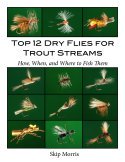 Top 12 Dry Flies for Trout Streams: How, When, and Where to Fish Them
Top 12 Dry Flies for Trout Streams: How, When, and Where to Fish Them
Click here to get more information about
Top 12 Dry Flies for Trout Streams: How, When, and Where to Fish Them (the link to Amazon is at the bottom of the page)...
Top 12 Dry Flies for Trout Streams: How, When, and Where to Fish Them (the link to Amazon is at the bottom of the page)...
Top 12 Nymphs for Trout Streams: How, When, and Where to Fish Them, 2nd Edition, originally published as an e-book only, is now available on Amazon as a paperback...check it out! Click on the links below to go to the information page on Top 12 Nymphs (the link to Amazon is at the bottom of the page...)
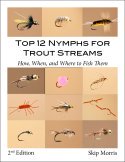 Top 12 Nymphs for Trout Streams: How, When, and Where to Fish Them (2nd Edition)
Top 12 Nymphs for Trout Streams: How, When, and Where to Fish Them (2nd Edition)
Click here to get more information about
Top 12 Nymphs for Trout Streams: How, When, and Where to Fish Them (2nd Edition). . .
Top 12 Nymphs for Trout Streams: How, When, and Where to Fish Them (2nd Edition). . .
Click here to get more information about Skip's e-book,
500 Trout Streams...
500 Trout Streams...
Skip's latest paperback book:
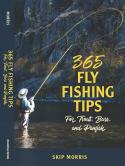 365 Fly Fishing Tips for Trout, Bass, and Panfish
365 Fly Fishing Tips for Trout, Bass, and Panfish
Click here to get more information about Skip's latest book,
365 Tips for Trout, Bass, and Panfish...
365 Tips for Trout, Bass, and Panfish...
Print Skip's chart for FREE:
Skip Morris's Trout-Fly Proportion Chart
Go to Skip Morris's Trout Fly Proportion Chart
Skip's Predator is available to buy...
Skip's ultra-popular Predator—a hit fly for bluegills and other panfishes and largemouth bass (also catches smallmouth bass and trout)—is being tied commercially by the Solitude Fly Company.
The Predator
CLICK HERE to learn more about or to purchase the Predator...
Learn to Tie Skip's Predator
Do you want to tie the Predator?
Tying the Predator
Skip shows you how to tie it on his YouTube Channel link, listed below:
CLICK HERE to see Skip's detailed video on how to tie the Predator...






